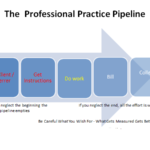One of the key benefits of preparing considered cash flow forecasts is that we are able to identify potential problems in advance-hopefully well in advance-certainly early enough to take some form of evasive action.
So, what can we do if we look to be headed for an overshoot?
We either have to increase the amount of cash coming in before the key date, or reduce the amount of cash going out before the key date.
Let’s concentrate on the cash out
At its simplest there are only three things that we can do to reduce the cash out in order to avoid exceeding our limit. These are
- We can defer expenditure
- We can make temporary cutbacks
- We can make permanent cost savings
Since the Covid crisis and its lockdown began most businesses including law firms have adopted the first two. This has been encouraged by the government schemes which were hoping to avoid long-term damage to the economy.
Deferring expenditure-this is often the easiest way to navigate a short-term pinch point. The government has been very keen for businesses to adopt this route by deferring various tax payments for several months. In other circumstances it can be a first port of call in dealing with operating expenses and can often be done without penalty. This can vary from simple manoeuvres like not putting the cheque in the post, through to agreeing monthly rent payments rather than quarterly. The big drawback however is that the liability to make the payment does not go away. The timing may be more palatable but may not have solved the underlying problem-but when it comes to managing cash flow do not underestimate the value of buying some time!
Temporary cutbacks-in the current environment the government has encouraged businesses to make temporary cutbacks rather than permanent ones, particularly through the CJRS Furlough scheme. This is an excellent solution to what the government perceived to be a short-term problem. Some businesses have gone further and agreed temporary reductions to salary levels in order to avoid making permanent cutbacks. But there are many other opportunities in managing expenditure to prioritise what is essential now and what can be deferred with little hardship. Some years ago, I was regularly able to cut firms office consumable expenditure by reducing the buffer stock that they held. In one large firm we rounded up sufficient stock to last them six months without having to replenish their supplies.
Permanent cost savings-if the cash flow squeeze is more than a temporary blip, and unless there is a substantial increase in income expected, meaningful permanent cost savings need to be made. These in turn come in two forms. If there is insufficient demand in the market for our service then we have to reduce capacity. In the legal world this means reducing the number of people we employ however hard and painful this may be. We then carry on largely as before but with less people producing less output.
If however the problem is not so much a lack of demand but an inability to make us sufficient margin from the work that we are doing, then we need to make Cost Reductions. This means that we have to change our processes and methods and stop doing things which add little or no value. These tasks are either automated or streamlined out of existence and we no longer need the people who currently perform them hence their roles will become redundant.
In the last recession the legal sector saw a great deal of Capacity Reduction, but relatively little Cost Reduction. This recession looks very different-technology, automation and process improvement all mean that the future could look very different and genuine Cost Reductions will be needed.




